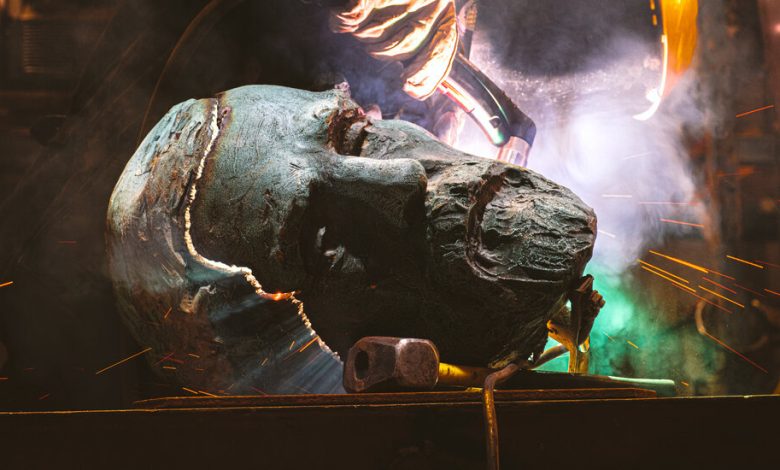The Most Controversial Statue in America Surrenders to the Furnace

Last Saturday in a small foundry, a man in heat-resistant attire pulled down his gold-plated visor, turned on his plasma torch and sliced into the face of Robert E. Lee. The hollow bronze head glowed green and purple as the flame burned through layers of patina and wax. Drops of molten red metal cascaded to the ground.
I stood next to Andrea Douglas and Jalane Schmidt, who had invited me to witness the last moments of the figure that had gazed down on Charlottesville, Va., from atop a massive steed from 1924, when it was installed, until 2021, when it was removed by the City Council. Dr. Douglas and Dr. Schmidt are the founders of the Swords Into Plowshares project, a community group that led a campaign to melt the statue down and use the metal to make a new public artwork.
It took most of the morning for the foundry workers to cut the monument into pieces small enough to fit into the furnace. Acrid fumes penetrated the respirators we had been issued. When the foundryman finally turned off his torch and tapped at the head with a mallet, Lee’s face fell clattering to the floor. “It feels like witnessing a public execution,” Dr. Douglas said.
Lee’s journey to the melting pot began more than seven years and two lawsuits ago, when a Charlottesville high school student, Zyahna Bryant, started a petition to remove the monument. “I am offended every time I pass it,” she wrote. “I am reminded over and over again of the pain of my ancestors.” The Charlottesville City Council voted to move the statue, but a lawsuit was quickly filed by a coalition of Confederate heritage supporters to keep it in place. A series of rallies by Klan members, white nationalists and others sought to protect the “world of gods and heroes like Robert E. Lee,” as Richard Spencer put it while leading a tiki-torch-lit march.
In August 2017 these demonstrations culminated in the Unite the Right rally, during which a white nationalist rammed his car into a group of counterprotesters, killing a woman named Heather D. Heyer and injuring dozens of others. Then came George Floyd and the summer of Black Lives Matter. In cities across the country, statues of Confederate generals attracted new scrutiny.
By my count, more than a hundred Confederate monuments came off their pedestals during our nation’s recent racial reckoning. But after those tumultuous months, the once-furious debate seemed to evaporate. Town councils shifted their focus; activists moved on to other issues.
Yet we never reached any consensus about what should become of these artifacts. Some were reinstalled with additional historical context or placed in private hands, but many simply disappeared into storage. I like to think of them as America’s strategic racism reserve.
What should we do with them? Just leaving them there for some future generation to deal with dishonors the intensity of emotions for all involved. But each possible outcome has costs and consequences. Each carries important symbolic weight. And no, we can’t just give them all to the Smithsonian.
The way our communities dispose of these artifacts may influence America’s racial dynamic over the next century, just as erecting them did for the hundred-year period now ending. Three years after George Floyd’s death, seven years after Ms. Bryant’s petition, 99 years after the monument’s installation and 158 years after the end of the Civil War, it’s high time we start figuring this out.
***
The Lee statue arrived in Charlottesville as a gift from Paul Goodloe McIntire, who returned to the city of his childhood after making his fortune as a stockbroker. Inspired by the City Beautiful movement, as well as by the desire of the city’s elite to make the downtown blocks into cultured, tranquil and white-only spaces, he also purchased and donated land for the creation of several parks. Lee Park (now Market Street Park) was one of them. The monument was commissioned in 1917, amid racial tensions that two years later would boil over into the Red Summer, when white mobs killed or injured hundreds of Black people during race riots across the nation. Days before the monument was unveiled, the Klan marched through the city.
Dr. Schmidt of Swords Into Plowshares arrived in Charlottesville to teach religious studies at the University of Virginia in 2007. She grew up in Newton, Kan., in a Mennonite intentional community that her adoptive parents helped found in the early 1970s. She entered Harvard Divinity School, planning to go into the ministry, and ended up with a master of divinity degree and a Ph.D. in religious studies.
Dr. Schmidt, who is biracial, described the Lee monument as “a lie from the time it was put in.” More than half of the residents of Charlottesville and the surrounding county were enslaved during the Civil War, meaning that “the majority of our community was elated when the Union troops came.” But she got involved only when she happened to attend a discussion the City Council had sponsored. Staff members and panelists outnumbered the people in the audience. The issue heated up quickly, though. Soon enough, Mr. Spencer was in town warning an angry crowd that when the multiculturalists were done with the monument, they’d come for white Americans. “They want to put us in a museum,” he said, “in a sense that they want to neuter us.”
But as her perspective evolved, Dr. Schmidt no longer wanted to put Lee in a museum. She was thinking of something much more primal.
Confederate monuments bear what the anthropological theorist Michael Taussig would call a public secret: something that is privately known but collectively denied. It does no good to simply reveal the secret — in this case, to tell people that most of the Confederate monuments were erected not at the end of the Civil War, to honor those who fought, but at the height of Jim Crow, to entrench a system of racial hierarchy. That’s already part of their appeal. Dr. Taussig has argued that public secrets don’t lose their power unless they are transformed in a manner that does justice to the scale of the secret. He compares the process to desecration. How can you expect people to stop believing in their gods without providing some other way of making sense of this world and our future?
Swords Into Plowshares might have been the first to propose melting, but other communities are working out their own creative visions for Lee’s afterlife. One of the biggest changes so far has been at Arlington House, the historic plantation mansion at the center of Arlington National Cemetery, which is the official national Robert E. Lee Memorial. In 2021, Arlington House reopened with displays not only about Lee’s family, who lived there after they inherited it from Lee’s father-in-law, but also about the lives of the families enslaved there. Even Lee’s burial site at Washington and Lee University in Lexington, Va. — where he served as president after the war — has changed. The university decided to focus on Lee the civilian rather than Lee the general, for example by moving a prominent portrait of him in uniform. And it constructed a wall to enclose the large sculpture of Lee that once claimed an insistent place in the university’s chapel.
Covering this story over the past few years, I’ve come to realize two things. First, when a monument disappears without a ceremony to mark why it is coming down, a community has no chance to recognize that it has itself changed. (Ideally the ceremony is public, but because of safety concerns, the melting I attended was not.) Second, if you are outraged that something’s happening to your community’s heroic statue of Lee, you’re not going to be any less outraged if the statue is moved to some hidden storeroom than if it’s thrown into a landfill. So if all changes, large or small, will be resisted, why not go for the ones with the most symbolic resonance?
That’s why the idea to melt Lee down, as violent as it might initially seem, struck me as so apt. Confederate monuments went up with rich, emotional ceremonies that created historical memory and solidified group identity. The way we remove them should be just as emotional, striking and memorable. Instead of quietly tucking statues away, we can use monuments one final time to bind ourselves together into new communities.
It happened with one of the first metal monuments to arrive in the American colonies. A gilded lead statue of George III, it was melted down in 1776 to make ammunition for the fight for democracy. Melting Lee down and turning him into something new is a violent act and also a hopeful one.
***
A very different process is consuming the world’s largest Lee, who rides, 76 feet tall, across the granite cliff face of Stone Mountain, just outside Atlanta. In 1915 a Confederate widow hired the sculptor Gutzon Borglum to carve Confederate figures into the cliff. After years of work that produced only Lee’s head, Mr. Borglum was accused of embezzlement and fired. He found a new set of patrons who, apparently unbothered by his involvement with the Klan, paid him to carve portraits of presidents into Mount Rushmore.
A replacement was hired, but the Stone Mountain project stalled until Marvin Griffin won Georgia’s governorship in 1954, on an anti-integration campaign. He arranged for the state to take over the monument as “a rallying point for all of us who believe in preserving the ideals for which our forefathers fought.”
Millions of people a year now visit Stone Mountain Park. They are there for such attractions as golf, paddle boarding and a display of animatronic dinosaurs. Many of them ignore the carving, which is visible only from a small area of the park.

Credit…Audra Melton for The New York Times
Brian Morris is a member of the Stone Mountain Action Coalition, a group working to distance the park from its past as a segregationist political statement. When I asked him what future he imagined for the carving, he joked that Vice President Kamala Harris could helicopter in to see it blown off the face of the mountain, just as Vice President Spiro Agnew helicoptered into the park to dedicate it in 1970.
But then Mr. Morris clarified that he would “hate for the mountain to be harmed by human hands any more than it’s already been harmed.” Instead, he would let nature continue to take its course. When I visited in the summer of 2022, it was already difficult to make out Lee’s profile. Lichen had spread over the carving’s surface, and runoff from the algae-fringed ponds inhabited by a rare species of fairy shrimp on the mountain’s top was staining it back to the color of the surrounding rock.
I was struck by how insistently the crowds of visitors gave the lie to the ideals of the Confederacy. Walking the trail to the top of the mountain, I saw families speaking Spanish, Hindi and Vietnamese and a queer couple holding hands. A buff runner played a Black Power speech from a speaker clipped to his backpack. I imagined Lee’s expression growing more and more dour under the lichen.
In his “I Have a Dream” speech, the Rev. Dr. Martin Luther King Jr. imagined the glory of a day when freedom would ring from the top of Stone Mountain. Maybe that freedom will come when the carving just fades into the background.
Or maybe not. This month the Georgia division of the Sons of Confederate Veterans sent a letter to park authorities, warning them that it intended to sue if the park permits the carving to “decay through lack of maintenance.”
***
When Charlottesville asked for proposals for what to do with the removed Lee statue, it got dozens of replies, including requests from people seeking to display it on private property. One Texan wrote that because the “city has no honor,” he would be happy to relocate the statue to a place where it could “be viewed by all patriots who wish to keep our heritage strong.” Instead, in December 2021, Charlottesville awarded Lee to The Jefferson School African American Heritage Center, which leads the Swords Into Plowshares project.
Contractors tipped the monument over and unscrewed the bolts holding the sculpture to its base. After some industrial-strength lubricant and some strategic wiggling of the horse’s legs, which were stuck like pegs into its torso, “it started coming apart fast,” Dr. Schmidt recalled. “Like a child’s toy.”
Night was falling by the time the pieces were loaded onto a trailer. But the largest section, with Lee mounted on the torso of the horse, was still just a little too large to fit. “His head was hanging off the side of the trailer,” Dr. Schmidt said. “So, for public safety reasons, we had to decapitate the statue.”
When the remaining legal barriers were cleared (including a last-minute lawsuit that sought to have the statue reassembled), Lee was finally ready to surrender to the furnace. The foundryman turned on the propane supply and laid Lee’s sword across the hole in the lid. He told the spectators that the metal had to get hot enough to release any moisture before he maneuvered it down through the hole into the crucible.
When he did, its blade stuck up out of the furnace for a moment, then melted down “like a stick of butter,” as Dr. Schmidt put it.
Lee’s face was the last piece to go into the crucible. Given how often the monument and its ideals were celebrated with flames — from Klansmen’s torches to the tiki torches of white nationalists in 2017 — it seemed fitting for flames to close over the monument.
Dr. Douglas, Swords Into Plowshares’ other co-founder, apologized that the ceremony could not be public. She thanked those in attendance, telling us we were witnessing it on behalf of Charlottesville’s residents, including those long gone who lived under slavery. Someday, she said, when we think of Civil War heroes, we will imagine not Lee but, instead, those who fought for their freedom against him.
The man in the protective visor dropped the red-hot piece of metal that once represented Lee on the ground. It fell to pieces, which he fed into the crucible. A line of cameras faced him, making new images of history as the old image finally disappeared in flames.
Erin L. Thompson, a professor at the John Jay College of Criminal Justice, is the author of “Smashing Statues: The Rise and Fall of America’s Public Monuments.”
The Times is committed to publishing a diversity of letters to the editor. We’d like to hear what you think about this or any of our articles. Here are some tips. And here’s our email: [email protected].
Follow The New York Times Opinion section on Facebook, Twitter (@NYTopinion) and Instagram.




